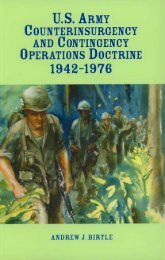C. Wiebes - Intelligence en de oorlog in Bosnië 1992-1995. De rol van de inlichtingen- en veiligheidsdiensten - Engels
C. Wiebes - Intelligence en de oorlog in Bosnië 1992-1995. De rol van de inlichtingen- en veiligheidsdiensten - Engels
C. Wiebes - Intelligence en de oorlog in Bosnië 1992-1995. De rol van de inlichtingen- en veiligheidsdiensten - Engels
- No tags were found...
Create successful ePaper yourself
Turn your PDF publications into a flip-book with our unique Google optimized e-Paper software.
185much contact with the population. The JCOs did rapidly meet ABiH repres<strong>en</strong>tatives, a consequ<strong>en</strong>ce ofwhich was that Karremans banned such meet<strong>in</strong>gs <strong>in</strong> the future, and he also banned the JCOs fromatt<strong>en</strong>d<strong>in</strong>g the regular meet<strong>in</strong>gs betwe<strong>en</strong> Dutchbat and the warr<strong>in</strong>g factions. The JCOs cont<strong>in</strong>ued withtheir pat<strong>rol</strong>s together with the commandos. In April, the fight<strong>in</strong>g <strong>in</strong>creased, and there were rumoursthat the VRS was go<strong>in</strong>g to attack the <strong>en</strong>clave. The local ABiH comman<strong>de</strong>r, Oric, seemed to havedisappeared; another SAS pat<strong>rol</strong> th<strong>en</strong> arrived from Zepa on a ‘visit’ to Srebr<strong>en</strong>ica. Dutchbat soldierVan Duijn recalled this <strong>in</strong>cid<strong>en</strong>t; he later became acqua<strong>in</strong>ted with a British soldier on an SAS course <strong>in</strong>the UK who had be<strong>en</strong> <strong>in</strong> the <strong>en</strong>clave <strong>in</strong> April <strong>1995.</strong> Van Duijn did not recall see<strong>in</strong>g the soldier, whichturned out to be correct, because the SAS soldier stated: ‘I arrived with a pat<strong>rol</strong> from the outsi<strong>de</strong>.’ Theywere look<strong>in</strong>g for Naser Oric, who had meanwhile left the <strong>en</strong>clave and was <strong>in</strong> Tuzla. The SAS soldierswanted to know where he was. Van Duijn later asked how they <strong>en</strong><strong>de</strong>d up <strong>in</strong> Srebr<strong>en</strong>ica; it seemed thatthe SAS unit had simply walked from Zepa to Srebr<strong>en</strong>ica. One of them spoke flu<strong>en</strong>t Serbo-Croat. 974On 25 May, Bosnia-Hercegov<strong>in</strong>a Command <strong>in</strong>formed the comman<strong>de</strong>r of the JCOs that anoperation aga<strong>in</strong>st the eastern <strong>en</strong>claves was a realistic probability, and that Srebr<strong>en</strong>ica would th<strong>en</strong> be thefirst on the list. This was passed on to Karremans, but he did not believe it. On 27 May, the VRSannounced to Dutchbat that it <strong>in</strong>t<strong>en</strong><strong>de</strong>d to capture OP-E. The VRS threat<strong>en</strong>ed to use force andDutchbat re<strong>in</strong>forced the OP; an offer of help from the SAS was rejected by Karremans, because he saidhe had <strong>en</strong>ough soldiers available. Subsequ<strong>en</strong>tly, on 3 June, OP-E fell <strong>in</strong>to VRS hands. 975On 8 June, the ABiH announced to Dutchbat that an attack on the <strong>en</strong>tire <strong>en</strong>clave was expectedsoon; the JCOs too th<strong>en</strong> reported that to Karremans. The JCO comman<strong>de</strong>r po<strong>in</strong>ted out afterwards,however, that such rumours circulated constantly and were difficult to take seriously. The JCOs hadfurthermore no <strong>in</strong>tellig<strong>en</strong>ce of their own that <strong>in</strong>dicated an attack. Only on 9 July was it clear to theJCOs that the VRS wanted to capture the <strong>en</strong>tire <strong>en</strong>clave. 976 Karremans consi<strong>de</strong>red the JCOs ma<strong>in</strong>ly aspot<strong>en</strong>tial Forward Air Cont<strong>rol</strong>lers and not so much as useful ‘<strong>in</strong>strum<strong>en</strong>ts’ for gather<strong>in</strong>g additional<strong>in</strong>tellig<strong>en</strong>ce. There were differ<strong>en</strong>ces of op<strong>in</strong>ion betwe<strong>en</strong> the SAS and Karremans on several occasions,and the battalion comman<strong>de</strong>r restricted the opportunities for their operational action consi<strong>de</strong>rably. 977Had the SAS gone aga<strong>in</strong>st the wishes of Karremans, they would have be<strong>en</strong> asked to leave the <strong>en</strong>clave.After the start of the attack, the JCOs contributed to guid<strong>in</strong>g NATO aircraft to VRS targets (forthis see compreh<strong>en</strong>sively Chapter 6 of Part III of the ma<strong>in</strong> Srebr<strong>en</strong>ica report). The JCOs were led byMajor Jacko and had their own communication equipm<strong>en</strong>t. Their mission was also to serve as ‘forwardobservers’ dur<strong>in</strong>g NATO air strikes. That this came too late, had, accord<strong>in</strong>g to Muslim witnesses, to dowith the fact that the JCO unit had refused to make a correct assessm<strong>en</strong>t of the severity of the VRS978attack. Ev<strong>en</strong>tually, the SAS would leave the <strong>en</strong>clave at the same time as Dutchbat. In May 1996, theDaily Telegraph revealed the pres<strong>en</strong>ce of the SAS <strong>in</strong> Srebr<strong>en</strong>ica, which had be<strong>en</strong> giv<strong>en</strong> the task ofreport<strong>in</strong>g to G<strong>en</strong>eral Smith <strong>in</strong> Sarajevo.The SAS also operated <strong>in</strong> the area of the Scand<strong>in</strong>avian battalion. This battalion was notauthorized to give or<strong>de</strong>rs to them. The t<strong>en</strong>-man SAS unit did not report to the Scand<strong>in</strong>avian battalionnor was this unit responsible for the safety of the SAS soldiers. An agreem<strong>en</strong>t was reached later withthe comman<strong>de</strong>r of Sector North East at least to know <strong>in</strong> which areas the SAS were located. Accord<strong>in</strong>gto comman<strong>de</strong>r Arlefalk of that battalion, the SAS soldiers moved ‘hither and thither’ and so979occasionally got caught up <strong>in</strong> skirmishes.In addition to British, there were also Fr<strong>en</strong>ch Special Forces active <strong>in</strong> Bosnia, especially <strong>in</strong> theSk<strong>en</strong><strong>de</strong>rija district of Sarajevo. A number of them came from the Fr<strong>en</strong>ch G<strong>en</strong>darmerie’s special974 Interview with L.C. <strong>van</strong> Duijn, 02/07/99. A British <strong>in</strong>tellig<strong>en</strong>ce source d<strong>en</strong>ied that a SAS pat<strong>rol</strong> ever walked from Zepato Srebr<strong>en</strong>ica. Confid<strong>en</strong>tial <strong>in</strong>formation (85).975 For this, see also Part III of the ma<strong>in</strong> Srebr<strong>en</strong>ica report.976 Confid<strong>en</strong>tial <strong>in</strong>formation (1).977 Confid<strong>en</strong>tial <strong>in</strong>terviews (43) and (49). Further: Tom Walker, ‘sAS Book on Bosnia blocked’, The Sunday Times, 09/07/00.978 Jon Swa<strong>in</strong>, ‘The Damned’, The Sunday Times, 12/05/96.979 Interview with G. Arlefalk, 18/05/00.





